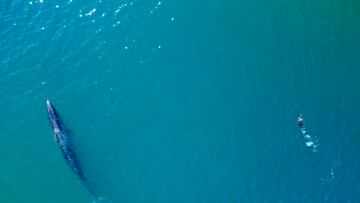An animal missing since 1929 has reappeared in the Patagonian sea
Once numbering in the hundreds of thousands, this whale was hunted to the point that no more could be found. The first has been spotted in almost 100 years.

After almost 100 years of abscence, a sei whale specimen has been sighted off the Patagonian coasts confirming the return of this species to Argentine waters after disappearing in 1929. The discovery is the culmination of work by a team of scientists from the National University of Patagonia San Juan Bosco and the National Patagonian Center.
Scientifically known as Balaenoptera borealis, this whale is considered the third largest species after the blue and fin whales. It can measure up to nearly 60 feet long and weigh more than 20 tons. Its physiognomy is more streamlined than the right whale and, unlike it, it is one of the fastest in the marine world.
This whale feeds on crustaceans and fish, although its main diet is krill. It has a life expectancy of between 50 and 70 years. According to the red list complied by the International Union for the Conversation of Nature (IUCN), this species is in danger of extinction. Although the exact number of specimens living today is unknown, it is estimated that there could only be between 10,000 and 50,000 of them left.
Disappearance due to mass hunting
In 1929, the sei whale had to flee Argentine waters in search of new habitats as a result of indiscriminate hunting. The reason for hunting them was that their fat served as fuel for lamps and candle wax, something highly valued in the market at the time.
According to Infofabe, it is estimated that around 300,000 of them were hunted and another 110,000 were captured in the southern hemisphere. This caused the population to plummet by 80%, a deafening figure that officially classified the species as “endangered”.
Furthermore, this species was not only hunted in South Atlantic waters, but also in the North Atlantic and Pacific where its numbers there too dropped precipitously.
Meticulous tracking
Researchers have spent decades analyzing and monitoring these cetaceans using various methods. Between 2003 and 2004 there were the first records of unusual columns of mist from a whale’s blowhole in the sea, typical of this species. That led scientists to incorporate a drone in their investigation so that they could collect samples in the deep sea.
From the extraction of small samples of skin and fat, and their subsequent analysis in a laboratory in Brazil, it was confirmed that they were sei whales. Consequently, the Argentine Air Force carried out various flights to estimate the presence of these specimens in the nation’s waters so that, researchers were able to place tracking devices on half a dozen specimens.
Following the recent discovery of one of these cetaceans off the Patagonian coast and, therefore, its consequent return to the Argentine seas, scientists are now launching new studies to obtain more information about this relatively unknown species. They want to know exactly what it feeds on and how it interacts with the rest of the species that live in the Patagonian area.





